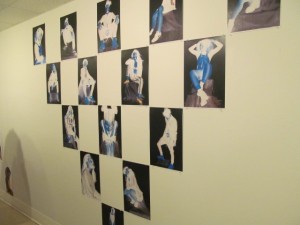By: Shannon Alomar
Special to The Chronicle
“When is the first time you noticed you were Black?” was the question that filled the student showcase room for Senior Fine Arts/Photography Major Kay “K. Ryn” Hopkins fourth gallery at the Hofstra University FORM Gallery.
According to Hopkins, the importance of this gallery is to represent the “black alternative” culture. The significance in the upside-down A, or black triangle, in the title of the gallery is also a subtle representation of the alternative black lifestyle.
When entering the room, your eyes are immediately drawn to the two triangular shapes made up of portraits. One triangle is facing upward and all of the photos vibrantly showcase their true colors, but the other triangle is upside-down and the colors in the photos are inversed. To the unknowing onlooker, it may seem like an artsy placement of photos, but Hopkins had a strategic plan behind the arrangement.
“I love triangles! Something about the shape does something to my soul. I wanted the triangles to represent black excellence… the triangle with the white background looks larger on the wall and all of the models are facing out, but in the inverted triangle, the photos look smaller and the photos are facing inward,” Hopkins said.
The audience’s attention was also drawn to a video of the models from the photos explaining the first time they noticed they were black. Hopkins said hearing their answers was interesting because depending on where the model grew up, their definitions of “blackness,” or the circumstance of that moment, their reflections added an authentic overview of a larger issue she was hoping to capture in her photographs.
“The question posed to the models is one that many blacks may face throughout their lifetime. I think watching the video and then seeing the photos show contrast between what they felt in that moment and how they stay true to themselves now,” an audience member said.
When asked asked about her connection to the alternative lifestyle, Hopkins said she never recognized she dressed alternatively until coming to Hofstra.
“At my high school [Central Islip High School], everyone dressed alternatively no matter their race, so there [it] was normal. Once I came to college and saw people staring at me I realized that maybe this is different. But, it was always normal to me,” Hopkins said.
Due to her own personal experience, she wanted to depict a positive black media image and emulate the the influence of the platform nationally known as AfroPunk.
“All the outfits the models wore came out of their own closets. It wasn’t staged. I didn’t tell them what to wear. I told them to be themselves and this was the outcome,” Hopkins said in reference to the modes’ attire in their photos.
As audience members walked about the room taking in the photographs, comparing the light and dark contrasts of the two triangles and discussing their personal viewpoints of the questions at hand, the vision Hopkins’s looked to have was acquired. In addition to the visual components displayed in the room, the conversations sparked up by her work is the lingering component of the gallery that will spread beyond the showcase room.
To learn more about K. Ryn and her works, you can visit her website at www.whoisryn.com

